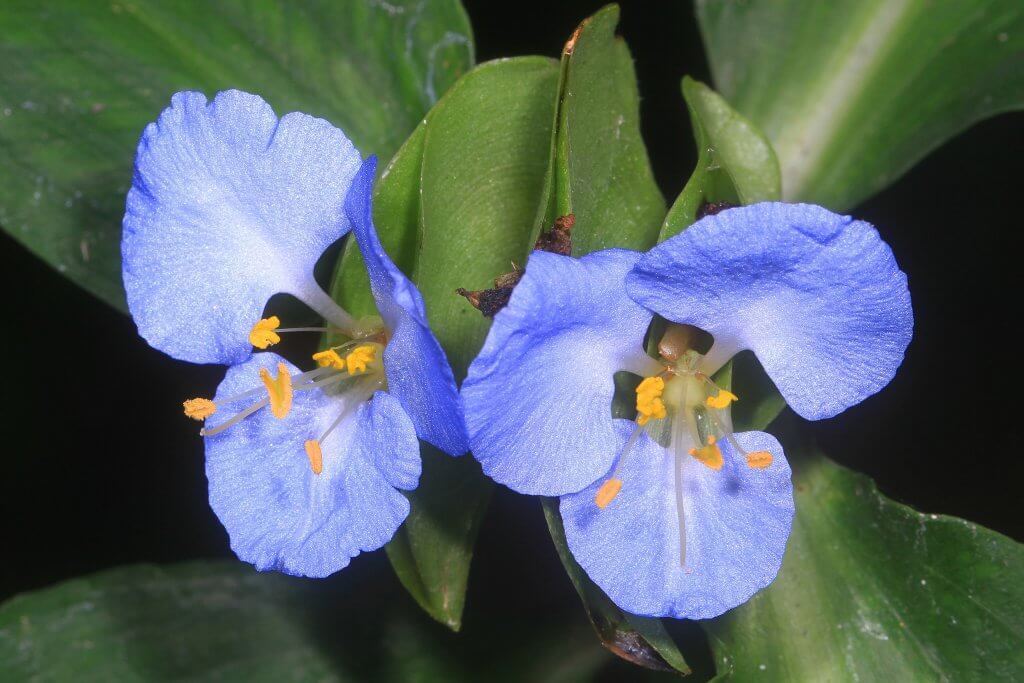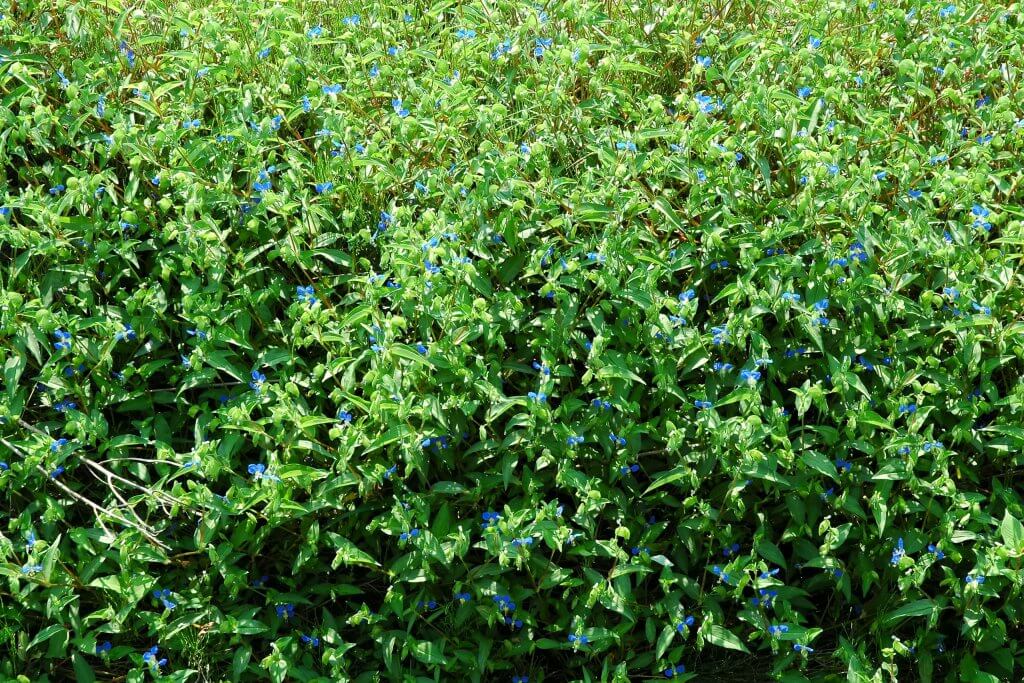Day flowers (Commelina spp.), are a group of flowering plants that inhabit all corners of the world, from Australia to Africa. The most prolific species are the Asiatic day flower (Commelina communis) and Benghal day flower (Commelina benghalensis). Both are originally native to wide areas of Asia, particularly China and India, however they have become largely naturalised in the west.
You are most likely to find the Asiatic day flower or the Virginia day flower (Commelina virginica) growing throughout the eastern and midwest states. The Asiatic variety likely arrived from colonisation and trading. Whereas the Virginia day flower is native to the middle eastern states, particularly Virginia as its name suggests.

Both of these plants can be found in moist areas, such as drainage ditches or near river banks. Other day flower varieties have however become adapted to different soil types. The white mouth dayflower (Commelina erecta) is native to the US, and you’ll instead find this growing in dry grasslands and prairies.
Day flowers have a very distinctive look, usually with two bright blue opposing flower petals sitting above a small and subtle greenish white petal and the floral axis. The Virginia dayflower however bears 3 bright blue petals. The leaves are alternating and lance shaped, appearing on short and weak stems which reach no more than a foot above the ground. The creeping stems tend to trail along the soil with new roots emerging from nodes.
Edible parts and other uses
The flowers, young leaves and young stems of day flowers can be harvested and eaten. They have a very mild, pea like flavoring, and the mucilage texture can add a generous leafy body to your salad. After thorough washing you can add these straight into a salad or sandwich. Or alternatively cook them through in a soup or stir fry, this is a better option if you have foraged leaves that are a little bit older.
In China, day flowers are often grown commercially on a small scale as a leafy vegetable crop, as it is popular in a number of localised dishes.
Within parts of Asia, the day flower also has a long history of use as a medicinal plant. From treating throat infections to fevers. Recent studies have concluded that a number of compounds in day flowers are in fact antibacterial.

Cautions
Although day flowers have a distinctive flower head, careful identification is still important. Take note not to confuse day flowers with ‘day lilies’ which, although edible, could in turn be confused for inedible lilies.
Foraging
Day flowers have the ability to spread quickly, hence their current weed status in a number of states. This means you are likely to find them in a number of areas with disturbed soil, from your own lawn to the edges of a hiking trail.
The best time to forage is during late spring and early fall, when new growth is sprouting. If you are after the flower heads, make sure to forage before the late afternoon sun, before the flowers wither away.
As they are not considered a threatened species, you can harvest as much of the plant as needed. Taking care to leave some of the population behind for other foragers to find and to allow the plant to re-establish the following year.

Did you know…
Day flowers are so called because of the uniquely short life span of their flowers. Once opened the flower heads bloom roughly for one day, before withering in the late afternoon. Flower heads are produced throughout the summer, so still have a chance of finding the blooms before they disappear.
Conclusion
Day flowers are an abundant plant that are often overlooked due to their small size. The flowers of the day flower, although brief, are very ornamental, and many landscape varieties have been bred to be sold as garden annuals. After harvesting, this tasty wild edible throughout the warmer months, you can also freeze a batch. This allows you to have some on hand throughout winter.
—————Written by Hannah Sweet
Hannah is a freelance writer and graphic designer from the UK. With a penchant for travelling, photography and all things botanical, she enjoys writing about a wealth of topics and issues, from conservation and slow living, to design and travel. Learn more about her writing and design services at www.sweetmeanders.co
Many of our readers find that subscribing to Eat The Planet is the best way to make sure they don't miss any of our valuable information about wild edibles.
See our privacy policy for more information about ads on this site







4 Responses
Thanks for this informative post. I am so glad that you researched this flower and plant.
Thank you for the information I have Day Flower’s in my garden I never knew they where edible Thank you for sharing 😊
Great information! I have this growing in every flower bed I have. Now I can harvest it for me and feed a friend’s bunnies too.
I have a large patch growing in my yard. I cut the tops off and feed them to my chickens. This causes them to grow back a lot bushier and with more flowers and eventually seeds for plants next year. My chickens love them.